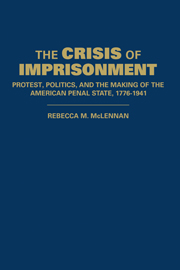Book contents
- Frontmatter
- Contents
- Acknowledgments
- Introduction: The Grounds of Legal Punishment
- 1 Strains of Servitude: Legal Punishment in the Early Republic
- 2 Due Convictions: Contractual Penal Servitude and Its Discontents, 1818–1865
- 3 Commerce upon the Throne: The Business of Imprisonment in Gilded Age America
- 4 Disciplining the State, Civilizing the Market: The Campaign to Abolish Contract Prison Labor
- 5 A Model Servitude: Prison Reform in the Early Progressive Era
- 6 Uses of the State: The Dialectics of Penal Reform in Early Progressive New York
- 7 American Bastille: Sing Sing and the Political Crisis of Imprisonment
- 8 Changing the Subject: The Metamorphosis of Prison Reform in the High Progressive Era
- 9 Laboratory of Social Justice: The New Penologists at Sing Sing, 1915–1917
- 10 Punishment without Labor: Toward the Modern Penal State
- Conclusion: On the Crises of Imprisonment
- Select Bibliography
- Index
9 - Laboratory of Social Justice: The New Penologists at Sing Sing, 1915–1917
Published online by Cambridge University Press: 18 August 2009
- Frontmatter
- Contents
- Acknowledgments
- Introduction: The Grounds of Legal Punishment
- 1 Strains of Servitude: Legal Punishment in the Early Republic
- 2 Due Convictions: Contractual Penal Servitude and Its Discontents, 1818–1865
- 3 Commerce upon the Throne: The Business of Imprisonment in Gilded Age America
- 4 Disciplining the State, Civilizing the Market: The Campaign to Abolish Contract Prison Labor
- 5 A Model Servitude: Prison Reform in the Early Progressive Era
- 6 Uses of the State: The Dialectics of Penal Reform in Early Progressive New York
- 7 American Bastille: Sing Sing and the Political Crisis of Imprisonment
- 8 Changing the Subject: The Metamorphosis of Prison Reform in the High Progressive Era
- 9 Laboratory of Social Justice: The New Penologists at Sing Sing, 1915–1917
- 10 Punishment without Labor: Toward the Modern Penal State
- Conclusion: On the Crises of Imprisonment
- Select Bibliography
- Index
Summary
Men can stand vermin and dirt and disease, but they cannot survive injustice.
Thomas Mott Osborne (1914)The received historiographical wisdom about the prison reforms of the high Progressive Era (1913–19) holds that the new penologists sought to remodel the prison on society and that they did so out of the conviction that prisoners could be rehabilitated if, and only if, the prison socialized them to be honest, self-governing citizens. Certainly, this is how the new penologists understood and represented their mission: Just as William R. George, in the 1890s, had imagined he was constructing an authentic replica of the American republic at George Junior, when Thomas Mott Osborne fostered the establishment of voting, prisoner government, entertainments, schooling, and athletics at Auburn Prison in 1913, he did so in the belief that he was replicating as nearly as possible the true relations of free society. Osborne appears to have genuinely believed that if prisoners partook in the same kinds of activities in which the free citizenry engaged, they would become good and productive citizens.
In the early 1910s, however, the society upon which Osborne and other new penologists claimed to be modeling the new American prison was far different from the one they imagined. Whereas the new penologists conceived of an America in which labor and capital, men and women, Catholics, Jews, and Protestants, teachers and pupils, immigrants and natives, and white men and black men had broken their “falsely” antagonistic bonds and realized their common interests, the society in which Americans actually lived and worked in the early 1910s was in the throes of widespread, and frequently violent, upheaval.
- Type
- Chapter
- Information
- The Crisis of ImprisonmentProtest, Politics, and the Making of the American Penal State, 1776–1941, pp. 376 - 416Publisher: Cambridge University PressPrint publication year: 2008



